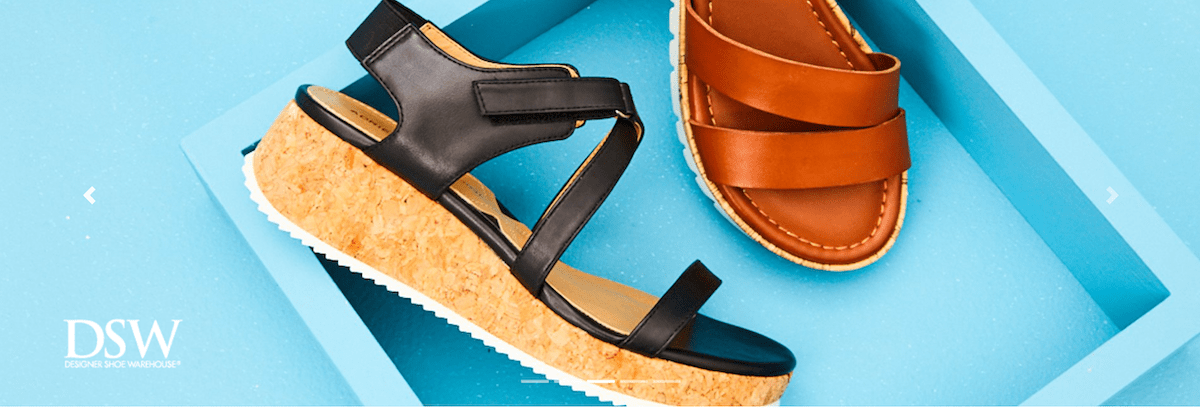DSW parent Designer Brands is betting on owned brands for growth

Designer Brands wants to be known for much more than DSW.
Over the past few years, the company has steadily increased its number of owned brands in hopes of capturing more of the footwear market. In 2018, Designer Brands acquired Camuto Group, which oversees Vince Camuto and footwear licenses for Lucky Brand and Jessica Simpson. The last year alone, Designer Brands added Le Tigre, Topo Athletic and Keds to its portfolio. It is currently working to finalize an agreement that would make it the exclusive licensee for Hush Puppies in the U.S. and Canada.
Last April, Designer Brands announced that it wanted to double sales from its owned brands — which it defines as “brands we have rights to sell through ownership or license arrangements” — to account for nearly one-third of revenue by the 2026 fiscal year. Designer Brands’ push into owned brands comes as more footwear companies pursue direct-to-consumer avenues like their own stores or digital platforms. DTC accounted for 14% of Designer Brands’ revenue in 2021. It wants to bring that up to 21% by fiscal 2026.
Designer Brands is making progress on its goals. For the three months ending Jan. 28, 2023, sales from its owned brands made up a little more than 23% of total sales, Designer Brands revealed Thursday. For the 2022 fiscal year, Designer Brands reported a 32.1% year-over-year increase in sales for its owned brands.
Outside of owned brands, Designer Brands continues to act as a retailer for major footwear brands like Birkenstock and Crocs. On Thursday’s earnings call, DSW president Doug Howe, who will become CEO of Designer Brands on April 1, was careful to note that “our goals to maintain strong partnerships with national brands, while doubling owned brands, are completely complementary.”
Other aspects of Designer Brands’ earnings are less sunny. The company reported a 7.5% drop year-over-year in fourth-quarter net sales. Its quarterly gross profit dropped from $254.2 million in 2021 to $222 million in 2022.
Designer Brands “was buffeted by a pullback in consumer spending in the last quarter, especially in the U.S.,” Neil Saunders, managing director of GlobalData Retail, told Modern Retail. “Footwear is a very discretionary category and a lot of shoppers have been prioritizing buying new clothing over buying new shoes… While DSW will benefit from its value stance, it will struggle to grow the top line in 2023 as consumers hold back a bit on spending in the footwear category.”
Ad position: web_incontent_pos1
To that point, Designer Brands’ executives did warn of a slowdown in sales and earnings for the first half of 2023. This was based on the assumption that “the pressure facing our customers will continue” throughout that period, Howe said. “That being said, we do believe these trends are temporary,” he added. “With that in mind, we are laser-focused on what we can control to deliver profitability that continues to be above historical levels.”
Part of this involves better controlling inventory levels and “continuing to be thoughtful about how we are playing in the promotional space,” Howe said. But, the company also hopes that its owned brands, which typically sit at a lower price point than some national brands it carries, can power some growth.
Owned brands carry many advantages, Brad Jashinsky, director analyst at Gartner, told Modern Retail. For one, “store brands can be created for specific customer demographics, style trends and price points,” he said. “Retailers with store brands are not at the mercy of other brands to supply products.” Boosting owned brands, too, can guard against retail giants pulling wholesale agreements, Jashinsky said. Nike, for instance, announced in 2021 that it would stop selling shoes to DSW to better concentrate on its DTC channels.
For years, Designer Brands’ owned brands have covered dress shoes and seasonal shoes like boots and sandals. Now, with Topo Athletic and Keds, Designer Brands can better reach additional customers looking for athletic and casual shoes for themselves and their families. Those markets on their own are quite large; according to Allied Research Market, the global athletic footwear market is set to reach $165 billion by 2030.
Acquiring Topo Athletic and Keds fits in with larger industry trends, Beth Goldstein, footwear industry analyst at Circana, told Modern Retail. Fashion and dress categories “outperformed” in 2022 as people began buying new clothes to wear to special occasions, she said. However, “more casual and athletic-oriented categories remain the lion’s share of the footwear business,” Goldstein added. “I expect that the focus will start to shift back there.”
Ad position: web_incontent_pos2
Ultimately, there are some drawbacks to owned brands, Jashinsky pointed out. Growing owned brands means growing store inventory, which can be challenging for retailers to manage. And, building up that brand “requires additional investments in advertising, marketing, manufacturing/sourcing, etc. that can take time to pay off,” Jashinsky said.

